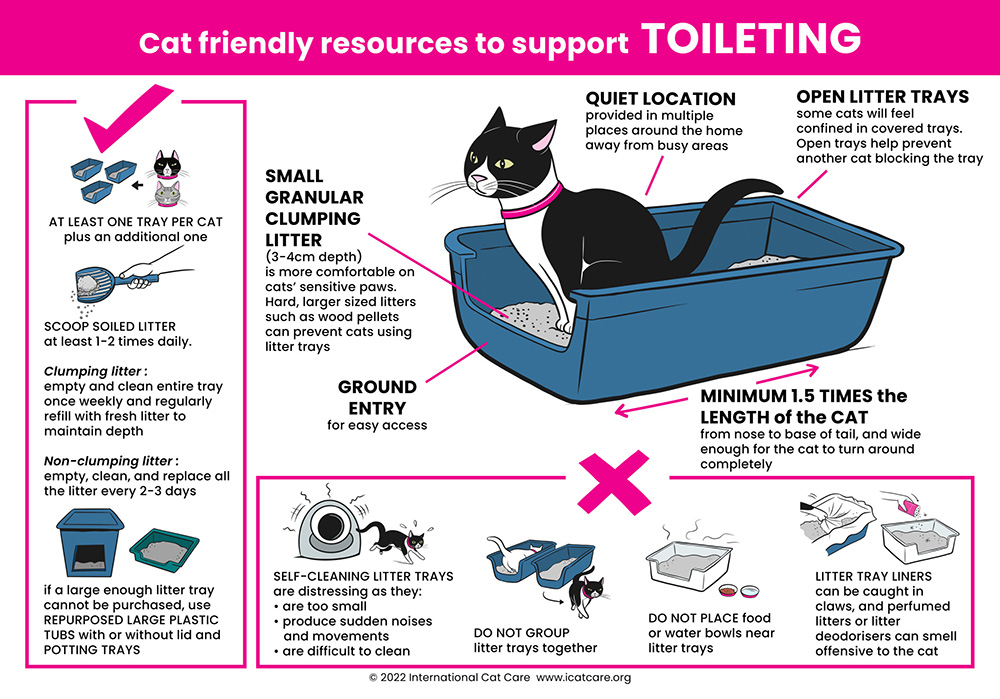Cats
litter tray tips
Believe it or not choosing the right litter tray and its position is very important.
They come in various shapes and sizes, so its hard to know what your buying is suitable, also we need to consider the fact that cats needs change throughout their lives, for example we may have to change litter trays to suit the needs of elderly cats, and also if the dynamics of the house change, like an introduction of a new cat, so what’s good now, may not be in the future.
Regardless of choice, research shows that cats like a depth of at least 3-4cm of litter, and have ample room to move around freely, the ideal length should be one and a half times the length of your cat.
Open trays
Many people start with an open top when they have a kitten, these are easier when you need to litter train, as we do not have the cover obstructing us should we need to intervene, Kittens will always try and eat the litter when they first see it, or even try and eat the faeces.
These open trays may not suit large cats, or cats that like to urinate with their tail in the air, as the urine may shoot over the back of the tray.
Some cats like privacy when using the litter tray, so having an open top will have a negative effect, and your cat may soil elsewhere in the house. On the other hand, some cats feel vulnerable confined in small spaces with only one exit point, this is particularly true for some cats who share a home with other cats that they don’t get along with, so an open top may be better.
Closed trays
Closed trays are the most preferred with owners, as it can help contain smell and the appearance. Most come with a removable lid and a removable cat flap style entrance, so you can accommodate the preference of the cat.
Some closed trays on the marked are self-cleaning, which sounds great for us humans, but having a litter tray that can make sudden movements and noise can cause your cat to be uncomfortable and may not use it at all.
Regardless of choice, research shows that cats like a depth of at least 3-4cm of litter, and have ample room to move around freely, the ideal length should be on and a half times the length of your cat.
Positioning
- Do not group multiple litter trays together for multicat households
- Do not place in a noisy environment, for instance near washing machines, or heavy traffic areas.
- Do not place near food and water
- Do not place near a full-length glass window or a cat flap
Choose somewhere quiet and discreet, and be mindful of how your cat approaches a litter tray, this will give an indication on how relaxed they are going to use it.
Types of litter
There are no hard and fast rules here, and there are many types out there with varying price tags. Choices range from, clumping, non-clumping, sand & wood pellets, its best practice to see how your cat likes your chosen litter. If they are not comfortable walking on it, then it’s time to change.

Cleaning the litter tray
Most household cleaners are toxic to cats, so its always a good idea to use a pet safe solution, or use a mix of biological washing powder and water, the biological powder helps breakdown the urine. Biological washing powder is also good when cleaning up inappropriate urination or scent marking in the home, instead of using household cleaners that contain ammonia, which can mimic the smell of the urine, this is why cats will often go back to the place they soiled, as it still smells like urine to them.
stress in cats
Cats are complex creatures, although cats come and go as they please and tend to have the ‘fend for themselves label’ this does not negate the fact that they suffer from stress. As a species they are constantly looking for threats or imminent danger everywhere they go and in every situation, from outdoor to indoor, things that stress your cat are usually things that we wouldn’t find stressful at all, it’s totally different.
Stress is a significant trigger for most behavioural problems, such as house soiling, anti-social behaviour or aggression, it can also have an impact on their health.
We here about the importance of socialising puppies, but equally this is also important for Kittens, as a lack of socialising indoors and outdoors will have a detrimental effect on the cat later on in life.
Signs of acute stress are
- Wide eyes, pupils fully dilated
- Vocalisation, yowling / growling / hissing
- Drooling
- Urination / defecation
- Ears flat to the head
- Body posture – tucked tail, ears flat to the head, whiskers back, crouched on all fours
- Rapid breathing
- Shaking
What can stress a cat
The biggest factor of stress we find are in multicat households, where the cats are not fond of each other, even if they tolerate each other this is still a stress factor.
If you have a multicat household, then it is vital they have enough resources, so they do not have to share. There should be multiple beds, 1 litter tray each cat and an extra one, separate food bowls, and separate feeding stations. Can you imagine sharing something with someone you don’t like, not pleasant right!
Territory is another factor, if you have a high concentrations of cats in the neighbourhood, and the other cats are coming into your cat’s space, urinating or scent marking, this is also a trigger. Castration can sometimes help with this, as the need to compete can be suppressed by the lack of testosterone.
Chronic stress
Chronic stress develops over a long period and the signs may be more subtle.
Signs of chronic stress
- Over grooming
- Hiding more
- Sleeping more, reduced play, spending more time indoors
- Urine marking indoors
- Inappropriate urination and or defecation
- Increased facial rubbing
- Defensive with people or cats
- Getting startled at the slightest noise
- Strange behaviour
How to help
Cats like routine and predictability, this minimises the need to worry about what’s going to happen.
Adding more cats to the household seems like a good idea to offer company to your other cat but this can often have a negative effect.
Socialising when they are kittens, subjecting to traffic noise human noise inc children.
Always allow your cat to come to you, this is the easiest way to see how your cat is comfortable interacting with you, and builds trust going forward.
Having a daily routine with feeding, again cats love predictability.
There needs to be multiple hiding places, cat like to be high, even cardboard box or bed on top of a wardrobe will be great.
The litter tray position is important, if it’s positioned in the open for all to see and it’s easy to disturb the cat then they may feel too vulnerable to use it, or will be forced to be in a vulnerable position using it. Do not position them close to noisy equipment like televisions, washing machines etc. The best place is in a quiet corner, where the cat only has one or two directions to look out at, rather than it being in an open space, never close to a cat flap or a patio door, due to the perceived threat from outdoors.
If your cat is going to be, or is currently an outdoor cat, then let your cat choose the time he or she wants to go out, cats communicate through scent marking, if you have a heavily populated area, then your cat needs to feel comfortable going out, we may not see cats around, but cats know who’s out and about, so its best they decide when is a good time.
If you have an outdoor cat, then you need to provide a challenging environment which encourages play, and physical activity, cats need to behave like cats, and suppressing some behaviours can be stressful, we understand that some people feel like their cats are safer kept indoor, which is fine providing you cater for they needs.
The ICC have the following guidelines

